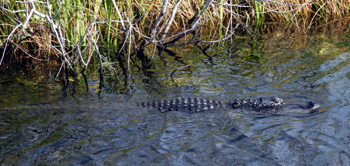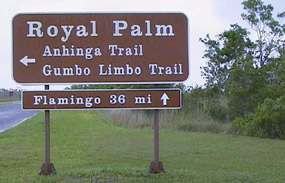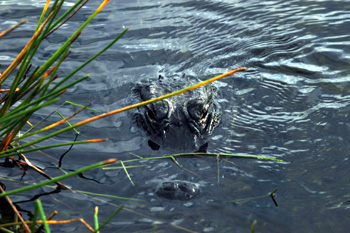
Wildlife fascinates visitors to Everglades
FLAMINGO, Fla.— Crocodiles have a clean record.
Alligators would too, had it not been for a minor incident a few years back when one bit a swimming lad who got too close, prompting the child’s mom to come to the rescue.
Sharks have been known to nip at fishermen’s hands sporadically, but never, to date, savor tourist flesh.
Much to many visitors’ surprise, however, wildlife outbursts of rage are exceptional in the Everglades National Park.
 |
An alligator at Royal Palm’s Anhinga Trail (Staff photos). |
“Many people are quite disappointed to find the animals don’t behave like they do on the Discovery Channel,” said Brian Ettling, a 33-year-old boat captain who’s been based in the Flamingo Bay area of the park for more than nine years.
His response: the American crocodile is a sweetheart compared to their Nile River cousins.
For starters, the animals aren’t anatomically fit to live an active predator’s lifestyle. In fact, most eat only once a week, soaking in most of their energy from the sun.
“People who come here from big cities don’t know what to make from large animals,” noted Ettling. Many, he said, leave disappointed at the lack of action from the animals, while others get a bit too trusting.
Asked to name the highlight of his trip to the Everglades, John Dewilde, from Alexandria, Va. said, “It’s hard to beat the crocodiles. One of them we saw looked like he was waiting for some dinner. He had his jaws up on a branch.”
That didn’t frighten him too much.
“From what they say, you really have to go up and annoy them,” said Dewilde. “They aren’t like the ones from Australia.”
The fact that they’re sitting still doesn’t mean they won’t react if they feel threatened, warned Ettling, who recalled a group of spring breakers who recently jumped in the water and splashed around carelessly until park rangers pulled them out.
 |
Plenty of alligators have been seen in the water around at Royal Palm’s Anhinga Trail and crocodiles are often spotted at Flamingo on Florida Bay. |
Swimming in the Everglades is sternly discouraged by the park’s staff, as is flipping over in a canoe or kayak. Even quick Eskimo rolls get scant regard.
Feeding the animals is another offense some visitors commit meaning no harm. Whether it’s the alligators, the Eastern Diamond Rattlesnake or the Red Shrouded Eagle, “it creates aggressive, dependent animals,” explained Ettling, who clarified he understands tourists mean no harm when they pop out a bag of chips attempting to get friendly with the creatures.
“For gulls, getting food out of the blue is the equivalent of you and me winning the lottery tomorrow,” explained the captain, marking how difficult it is to explain to newcomers what a devastating impact hand feeding the animals can have on their habitat.
“Basically, it becomes welfare for animals,” stressed Ettling, explaining that a sudden influx of food can have a devastating effect on the population of any given species.
However, there are more important lessons to be learned from the Everglades, according to Robert Parentli, 36, also a boat captain.
Many people, he said, arrive to the Everglades expecting the whole brochure scene of rich wildlife and speeding airboats to play out at theme-park speed.
“That’s when I tell them that coming to the Everglades is like visiting a friend at the hospital,” said Parentil. “That is, a friend who is in terrible shape.”
That metaphor gets most guests to lend an ear.
He explains to them that 100 years ago, the Everglades would have looked more like the pristine and savage image people today mistakenly expect. Indeed, according to historians’ accounts and scientific estimates, wildlife populations have eroded hastily during the past few decades, while urban areas continue to sprawl a few miles north, soaking up water and spilling pollution into the park.
“That’s the most empowering part of our job,” said Ettling. “It’s not like we turn every visitor into an Everglades crusader, but people go home thinking a bit differently.”
The changes in mindset range from taking better care of their backyards, looking closely at office-seekers’ environmental records before voting and purchasing brands that are less detrimental to Mother Nature.
 |
A young alligator at Royal Palm’s Anhinga Trail. |
The Everglades’ best kept secret, according to Ettling is the park’s gradual but powerful magnetism.
“When I came here nine years ago, I hated it,” he confessed, complaining about the heat, mosquitoes and the area’s flatness.
“With time, however, you learn that no matter how long you’ve been here, you never cross the same stream twice.”

Comments are Closed